In This Issue
The opinions, beliefs and viewpoints expressed in this publication are those of the authors. They do not necessarily reflect the opinions, beliefs, viewpoints or official policies of Autism Society Alberta.
|
|
|
My Neurodiverse Family &
Our Journey
Jason Kooy
My son Jabez was diagnosed with ASD (Autism Spectrum Disorder) Level 2 when he was six years old. His younger brother, Ethan, was diagnosed at five years old. Not to be outdone, I was diagnosed at 46 years old. Just for reference, the boys are now seven and six, and I am 47. It has been an interesting couple of years.
The bravest and most heroic person I have ever known is my neurotypical wife, Lenah. Lenah came to Canada in 2012 from Botswana in southern Africa. Without her, I would not be the father I am now. She is an example of a mother who has had to accept more than anybody could have expected; she is nothing short of remarkable. in southern Africa. Without her, I would not be the father I am now. She is an example of a mother who has had to accept more than anybody could have expected; she is nothing short of remarkable.
Our journey as a family strongly touched by ASD is certainly not unique. I know of several families that are raising children on the spectrum, and their story encourages and motivates me to continue to do all I can to be what my children need me to be.
It isn’t always easy.
Being on the spectrum myself, I can understand the frustration they show when routines are interrupted. I can see the necessity of rules and procedures being followed; because they have to be. I can see and understand them taking everything I say literally. I can understand the frustration of not being easily understood. The feeling of not being able to express themselves the way they would like to. I can understand words being caught somewhere between our brains and our mouths. I can understand not having a filter when it would be best to have one. I can understand the loneliness of not making friends easily. Adults and children can often be very similar when it comes to how they perceive those on the spectrum.
But it isn’t always hard.
I can understand the joy my boys feel when they figure out a problem and work together to provide a solution. Like myself, my boys both have “pervasive interests”, which is a fancy way of saying they will stick to a problem until they find a solution. It probably actually means they are interested in one subject at a time and will talk about it non-stop, but my 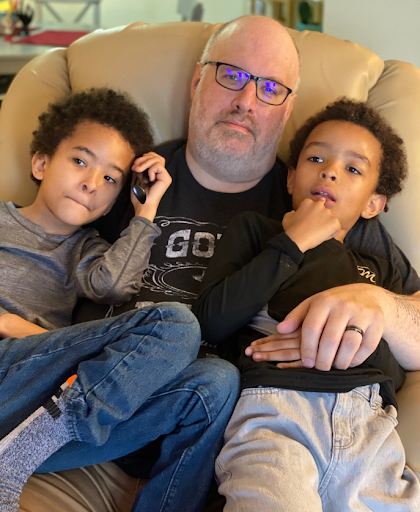 definition is better. When you see the world as an opportunity to find a solution – and you know that you will find it, life can become a fantastic mystery novel. Currently, my two boys are singularly focused on the solar system. All eight planets, and the dwarf planets. They are curious, and the question and answer periods we have enjoyed have motivated me to learn as much as I can, just to stay ahead. We recently visited a field and mapped out how far the planets are from each other, with the sun being a basketball. This simple game of measuring to scale (well, kind of; I would have had to get in a car and drive to map out the dwarf planets) provided us with an afternoon of discovery; an afternoon I wouldn’t trade. definition is better. When you see the world as an opportunity to find a solution – and you know that you will find it, life can become a fantastic mystery novel. Currently, my two boys are singularly focused on the solar system. All eight planets, and the dwarf planets. They are curious, and the question and answer periods we have enjoyed have motivated me to learn as much as I can, just to stay ahead. We recently visited a field and mapped out how far the planets are from each other, with the sun being a basketball. This simple game of measuring to scale (well, kind of; I would have had to get in a car and drive to map out the dwarf planets) provided us with an afternoon of discovery; an afternoon I wouldn’t trade.
I value and cherish the moments when my boys sit on the couch next to me and just cuddle. You see, I don’t enjoy “touch”. It’s a sensory thing. I am ok with my wife holding my hand, etc. But I am not a “hugger”. But when your kids, who don’t otherwise show a lot of affection, decide they need to cuddle up with dad for a few moments – I would not trade their neurodiversity for neurotypical for one second.
There is a quote by Johnny Seitz, an autistic tightrope walker. “Stop thinking about normal … you don’t have enough imagination for what your child can become”. When you live each day with “normal” in your rear-view mirror, and get to see these two kids experiencing the joy that comes with enhanced and limitless imagination, you can truly appreciate the journey.
I am not going to say that being diagnosed with ASD and having two boys also diagnosed with ASD is easy. It’s not. Not always. I am not going to say that your journey as a parent should be anything other than the journey you are currently experiencing. Your journey is yours. It is valuable.
Parenting with ASD is challenging and frustrating. But worth it. So worth it.
|
|
|
Autism Society of RMWB Update

Look what’s happening in Ft. McMurray this summer!
This neurodiverse adult social group is for 16 years plus. The Program focuses on building and maintaining friendship skills in group activities. These activities are held once a week on Tuesdays, from 12 pm to 2 pm.
For any questions please call 587-452-9334 or e-mail community@autismrmwb.org
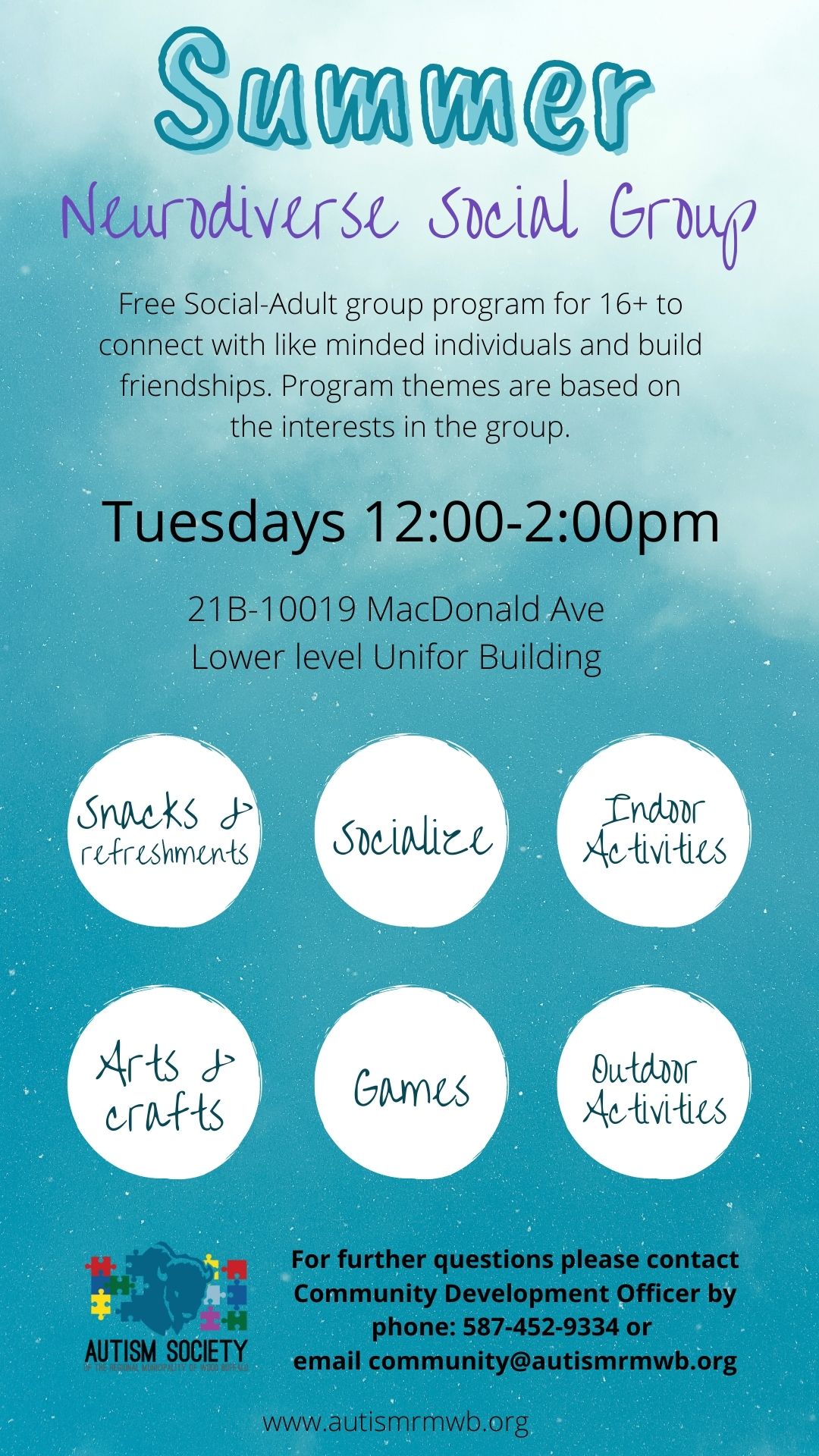
|
|
|
The Barriers to Being a Working Parent
Karla Power
Life-work balance is something that most of us strive for, but for some of us, many barriers stand in the way. When you have one or more children with extraordinary needs, you are needed in a greater capacity as a parent, and that can often conflict with working.
Parents of children with extra needs tend to have more medical appointments, specialist visits, and progress meetings to attend than typical parents. These appointments and meetings are usually booked during work hours, putting a working parent in a very difficult situation. The irony that parent-teacher interviews for typically developed children are held in the evenings to accommodate working parents, but IPP meetings for our children are held during the work day, is not lost on me. Even support meetings that are offered to families like ours happen from 9 to 10 a.m. during work hours, putting a working parent in a very difficult situation. The irony that parent-teacher interviews for typically developed children are held in the evenings to accommodate working parents, but IPP meetings for our children are held during the work day, is not lost on me. Even support meetings that are offered to families like ours happen from 9 to 10 a.m.
As someone who loves her job, I am often faced with the decision to take time away from my students and a job I love in order to tend to my own children’s needs. When I became a mother, I knew that my kids would always come first, but I didn’t realize how much juggling would have to be done to put them first.
As teachers, we are lucky to have some (4) family medical days that we can use each year, but it is not nearly enough. With two kids putting things in their mouths and picking up germs, those days tend to run out fast. Then add in appointments, home visits, and IPP meetings that happen three times a year.
Another factor to consider is that many of our children cannot tell us when they are feeling unwell. As parents, we can keep them home to monitor them more closely (since we know them best), or send them to school and risk getting the call that they are not well enough to be there, or are just too dysregulated to be at school.
For our family, we decided to lessen our stress by changing my work schedule to 90% for a year and a half, so that I could have an afternoon off every week to attend appointments and meetings for the boys. Unfortunately, that was not financially feasible in the long term, as it came with a significant pay cut.
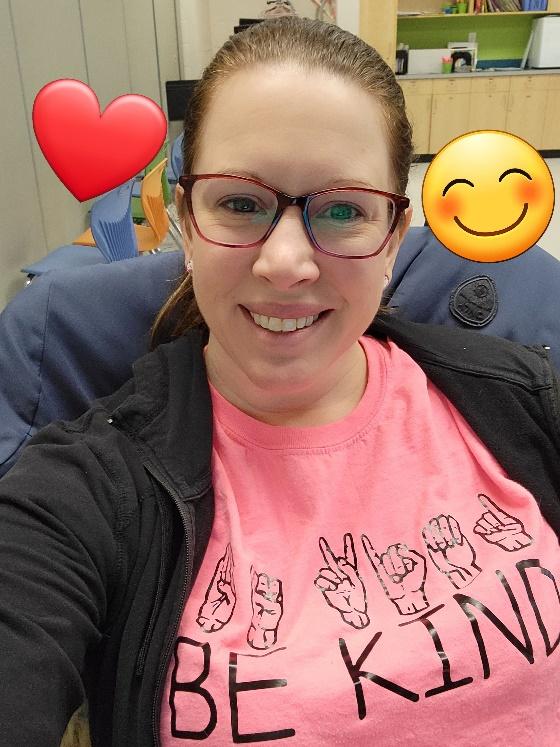
When talking to other parents of children with extra needs, they are faced with the same problem: choosing between their career and financial stability, or having the flexibility to be at home to tend to their children’s needs, but at a cost to their family income. Our families are used to making tough decisions, but it’s something we did not necessarily plan for when becoming parents.
Something that makes the decision even tougher is not being able to find appropriate and affordable child care. Many jobs start before school hours and extend past 3:00 p.m., so unless you have a very understanding employer, you will likely need childcare.
Unfortunately, many of the options that are available to other families are not available for families like ours. We are very fortunate to have found someone to watch the boys on Professional Learning Fridays next year, but we spent the last two months seeking after-school care for the boys, and every avenue we pursued was a dead end. Out-of-school care has a huge waitlist and is pricey. Every qualified person we know already has a job, and daycares either couldn’t provide transportation or simply weren’t able to accommodate the boys. We have had awesome childcare for the past six years, so we were not willing to settle for less for our boys, especially considering that they are non-verbal and unable to tell us if a person is not treating them well.
As a family, we decided that our best bet was to divide and conquer, so 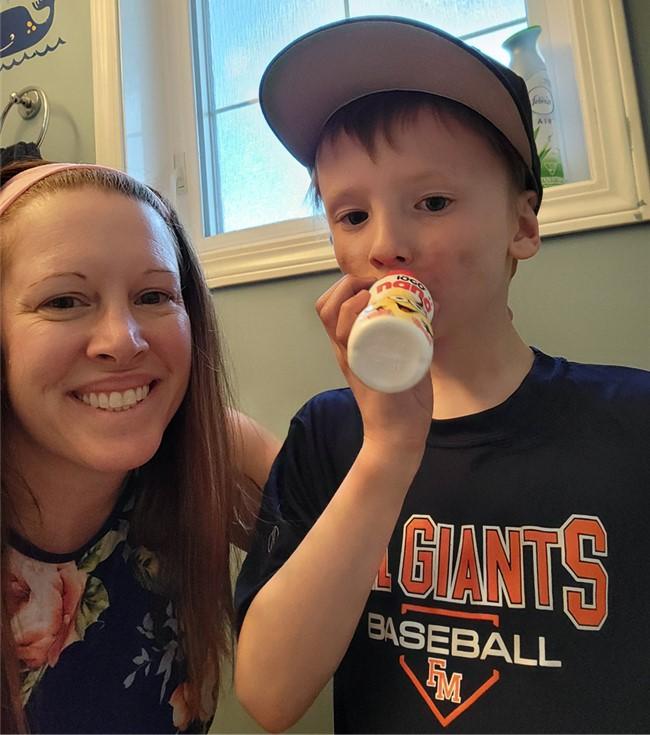 we ended up transferring Paddy to my school so that we would each have a child before and after school, rather than Frank having both. Sometimes I wonder if staying home would just be easier, but I cannot fathom leaving a job I love so much. I choose to work for my mental health, and because I find staying at home isolating. Also, to help pay the mortgage! we ended up transferring Paddy to my school so that we would each have a child before and after school, rather than Frank having both. Sometimes I wonder if staying home would just be easier, but I cannot fathom leaving a job I love so much. I choose to work for my mental health, and because I find staying at home isolating. Also, to help pay the mortgage!
My hope is that in the future, more accommodations will be made for families like ours, so that we can pursue our careers while also being able to take care of our children’s needs. I hope that more childcare options will become available, that specialists and school staff will be willing to work with us after hours, and that employers will give their employees more options to take days off; using a family sick day to attend a meeting just doesn’t seem right. For now, we will deal with these barriers as a family and try our best to support our boys while we pursue our careers.
|
|
|
Autism Calgary's Keeping It Together (KIT)

Keeping It Together (KIT) is now operating on a hybrid model, with the option to attend either virtually or in person! So now you can attend from anywhere in Alberta. The meetings take place on the 2nd Thursday and the 4th Monday of each month. This is a self-care group for the mothers of children, youth, or adults on the autism spectrum, and meetings will often feature fun activities.
Please note that due to the new hybrid model of KIT, we now require pre-registration on Eventbrite. To attend, please register here.
For more information visit https://autismcalgary.com/kit/.
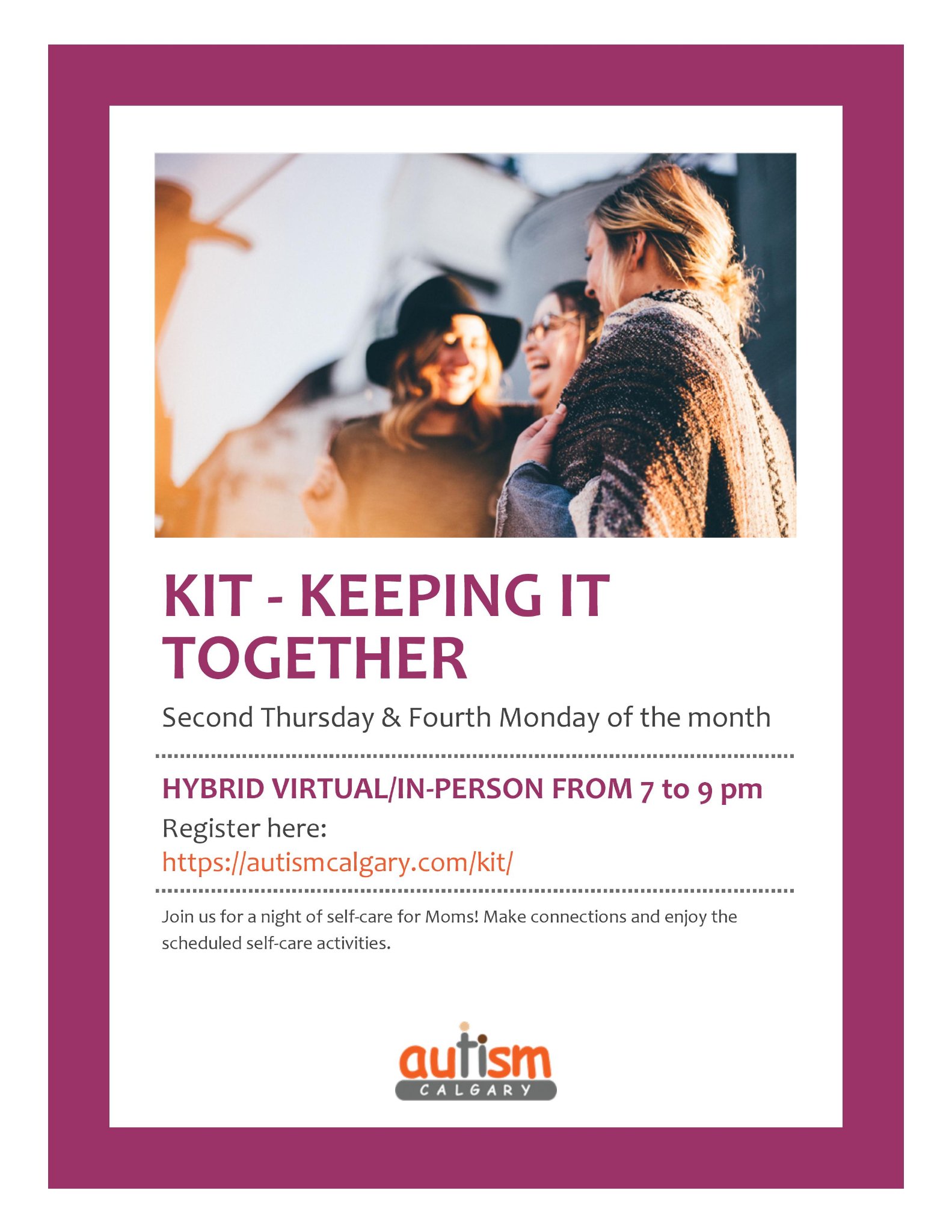
|
|
|
Task Analysis – Part 2
Carmen Moore
This month, I will continue the series on the evidence-based practice (EBP) of ‘task analysis’. Once again, task analysis is the work of breaking down complex skills into smaller, more manageable steps. In part one we discussed the appropriate goals that can be addressed using this strategy, as well as the more detailed information on forward/backward chaining and ‘total task’ presentation.
My husband has been teaching our son to pack his own lunch, and he likes his sandwich meat packed in a particular way. I showed my husband how to model the entire task, encourage my son’s attentiveness (so there was no wandering away in the middle), and then have him try to do the specific task, step by step, modeling and encouraging each step of the way. It was very successful, and I thought, “Aha! Another successful task analysis paired with other research-based practices!” I have a different parenting experience I think, than some of my friends with neurotypical children, as I assume none of them have ever had that thought. husband how to model the entire task, encourage my son’s attentiveness (so there was no wandering away in the middle), and then have him try to do the specific task, step by step, modeling and encouraging each step of the way. It was very successful, and I thought, “Aha! Another successful task analysis paired with other research-based practices!” I have a different parenting experience I think, than some of my friends with neurotypical children, as I assume none of them have ever had that thought.
Now let’s look at how to use the practice of task analysis successfully. First, determine if the learner has the prerequisite skills needed to learn the task. For example, if the learner is expected to do the laundry but does not know how to sort the clothes properly first, that prerequisite skill can be taught beforehand. Another example could be if a learner is learning to cook, but has no knife or kitchen safety knowledge yet, that could be taught first. If a learner has weak fingers, one may need to help build up finger strength before tackling learning to print or tying their shoes. Do not assume that because the learner has some of the skills needed, they have all of the skills needed to successfully perform each step of the task. This is very important, as keeping the process ‘errorless’ will help to build positive momentum and success for all involved.
The next step is to identify each component of the target skill/behaviour. The smaller steps should be ‘discrete behaviours,’ which simply means that the step requires a single action or response and takes a relatively short time to complete. For example, this chart shows the steps that may be required for a student to successfully enter the school and prepare for the day. Each step may seem minor or even obvious to most, but by breaking each step down (and then pairing it with a visual, as you see below), the chances for success are much higher for the learner. This process can help to gain confidence and independence, which to me are two very important characteristics.
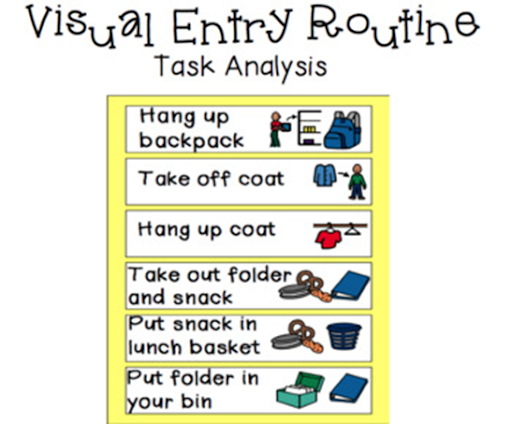
Step three is to check if the task is completely analyzed. When the task analysis is complete, it helps to double-check to see if:
- Each step is a discrete behaviour/skill
- The steps are manageable for the learner
- Each step is described accurately for the learner’s needs
The next step of implementation is to then decide which type of chaining you will do: forward chaining, backward chaining, or ‘total task’ presentation. Each of these has its benefits. Forward chaining can help an individual learn how to perform the task from beginning to end, and it may be helpful to view it in that mode. Backward chaining can be easier for the learner as they only have to perform the end step (then second last, third last, etc.), and feel it is manageable with some already done for them. The ‘total task’ method is used most often when teaching functional life skills, when the learner can benefit from direct modeling, practice, and reinforcement along the way.
Step five is to select the appropriate form of task analysis, and choose which other evidence-based practices may need to be implemented alongside, to make it as successful as possible. If you chose forward chaining, will you use any level of prompting, any reinforcers, any visuals needed, or any social stories to help prime/prepare the learner? Will you find any video modeling to use before, during, or after the process to help the learner perform the steps of the task? Often, the strategies can be ‘stand-alone’, yet might work much better when paired with one or more other strategies.
For step six, you will prepare any materials that will help the learner to experience success with this new or practiced multi-step task. For example, if the learner can read, the steps could be presented as a checklist to follow. For a younger learner or non-reader, visuals or pictures could be used to represent each step of the task. Another option could be to videotape a person performing the task from beginning to end, and have the learner watch it. There are benefits to this, as the environment and materials would be exact to the learner.
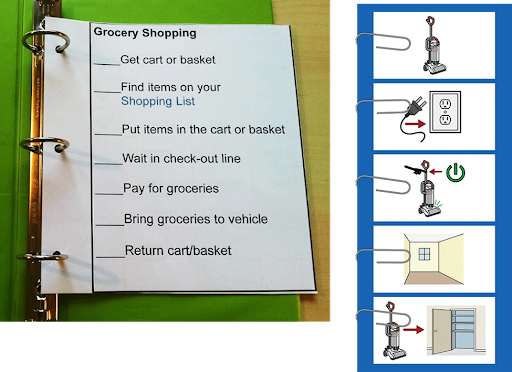
Much of the information in this article is from the related AFIRM online module, found here. Look for part three of this series next month, as I will continue to discuss the EBP of task analysis. This has been an excellent strategy for learning new skills, especially when involving multiple steps.
|
|
|
Sinneave Family Foundation –
EmploymentWorks

Are you a recent high school graduate and wondering what’s next?
Or do you want to enhance your job skills?
EmploymentWorks is a FREE program that offers job readiness training and hands-on practice in real workplace settings for autistic youth, adults, and people with disabilities. EW is perfect for those who are ready to develop and practice the skills needed to get and keep a job.
Our next in-person cohort begins August 2 at The Ability Hub in Calgary. For more information and to register, call 1-888-733-7976, email info@employment-works.ca, or visit our website here.

|
|
|
Dear Paddy
Frank Power
For my son’s 7th birthday, I wanted to type a letter highlighting his growth through the past seven years. Being a father to him has opened my eyes and taught me that there are so many special, unique people in the world, and I am lucky enough to be raising not just one, but two of them.
Dear Paddy,
Tomorrow we will celebrate the first day I met you and became a father. When you came into this world, I was excited and nervous about the path that was ahead. Your journey to number 7 has been a time in which I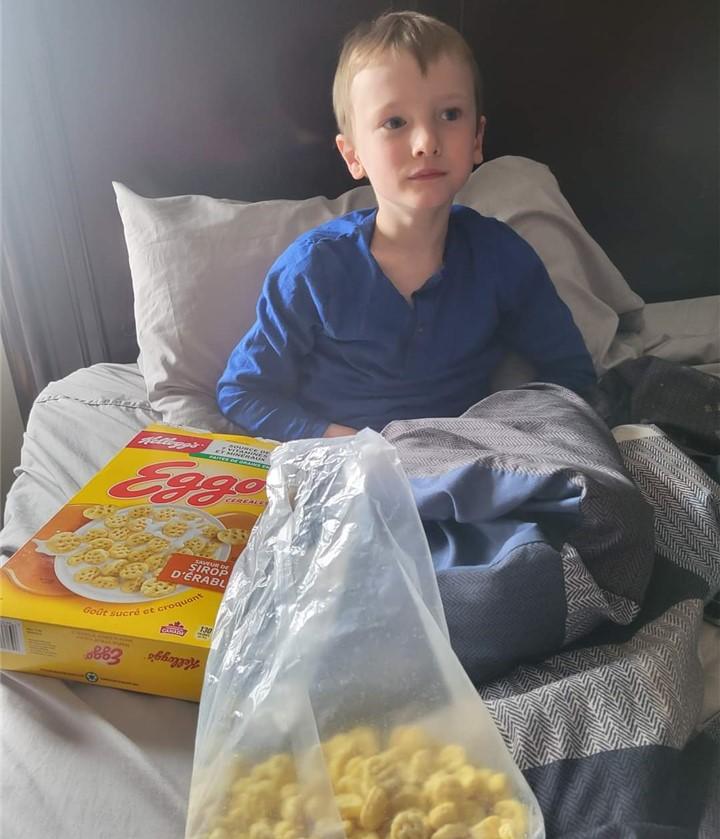 have learned a lot and seen how far you’ve come. We have been through so much, and life has not been easy, but your ability to make so many people around you better, without saying a single word, shows the impact you have. have learned a lot and seen how far you’ve come. We have been through so much, and life has not been easy, but your ability to make so many people around you better, without saying a single word, shows the impact you have.
You have been through evacuations, isolations, and more changes in your daily life than I can even imagine. The adjustments you have had in your schedule have not been easy on you or the family, but you have managed to show us that you are a strong person and are capable of so many things. You can climb just about anything. You have shown us you can ride a horse, swim in a pool, and become more independent at riding a bike.
You have shown how important it is for us to be a part of your world, from your smiles, eye contact, hand-holding, high fives, and most importantly those hugs you give. When someone is lucky enough to receive one of those, they truly know they have entered your world. The relationships you have formed with family, friends, respite workers, people from your school, and daycare demonstrate the many individuals who have been impacted by being around you and developing those important connections.
You're also a big brother, and the best brother anyone can ask for. Even though you and your brother Kelton are both your own people, I know  how much he looks up to his big brother, and loves it so much when you acknowledge him. Even though you are each into your own things, you're very aware of what the other is doing. You both communicate in your own ways, without words, but I know for a fact that you both understand each other better than anyone around you. how much he looks up to his big brother, and loves it so much when you acknowledge him. Even though you are each into your own things, you're very aware of what the other is doing. You both communicate in your own ways, without words, but I know for a fact that you both understand each other better than anyone around you.
Paddy, you have led me through your development, from a little boy to a young man. You’re continuing to grow up in front of my eyes. I get a front-row seat to see how far you have come. You show me that you have so much potential. It may not necessarily happen the way we would have thought, but I know and believe you will accomplish great things. You have so many people in your corner. Mom, Dad, and bro are so happy to celebrate the day of your birth, and are so excited to be there with you for many more to come.
So, happy birthday, Paddy Daniel Power. Thank you for making me your father, and letting me be a part of your life to date. Happy birthday to the guy that is the legend, because he shows me every day what he is capable of. There is nothing out there that you can’t make happen. Happy birthday to the boy whose continuous energy always keeps me on my toes, and my head on a swivel. Most of all Happy birthday to the boy who is not only my son, but my perfect friend.
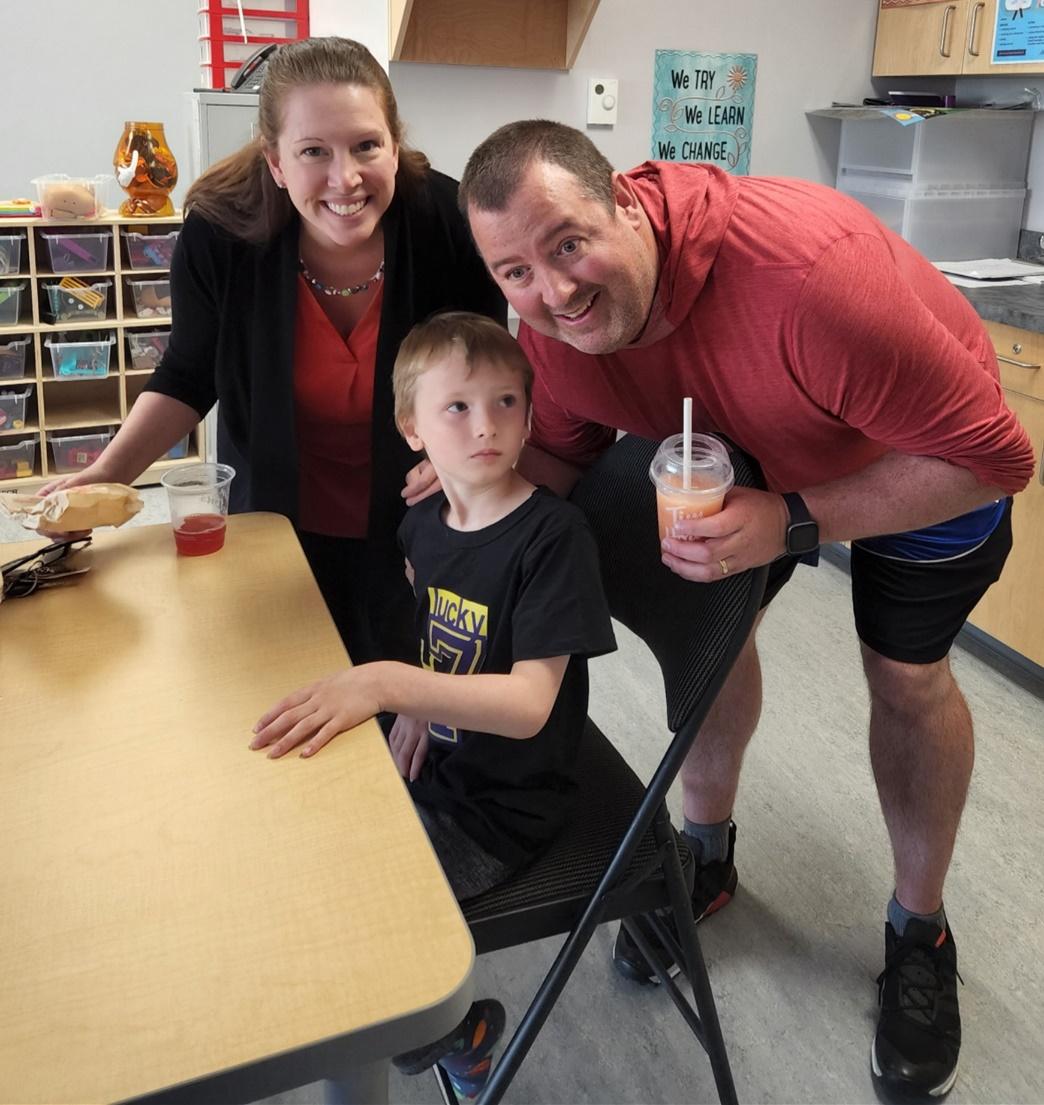
|
|
|
Autism Edmonton Update

Occasio is gearing up for a fun summer full of activities! We will be adding day-time activities alongside our regular evening and weekend programming, to try and meet the needs of everyone and ensure there is an opportunity for all to be involved. Click here and sign your child up today!

Tickets are NOW ON SALE for our "Poppies" - An Imagine Monet Gala. You can get more information and buy tickets, here.

|
|
|
Mealtimes: A Struggle for Families with Picky Eaters
Kassandra Rago & Venita Rajput
Eating is one of the most common daily functions we do as human beings. You could say much of our daily lives revolve around eating. It’s obvious that good nutrition is important for our health, but human beings eat for a variety of other reasons as well. For instance, social events are often centered around food, and we often celebrate religious holidays by gathering around a meal with family and friends. Many of us eat for no reason at all, except that we want a good snack while binge-watching our favourite Netflix show. Therefore, it is safe to say that feeling hungry is not the sole motivator for eating.
For some, the act of eating does not come naturally, and can be a cause of stress and anxiety. Feeding is a complex system that involves many  body systems working together to support the feeding process. When one of these bodily systems is not functioning well, it can affect how a person perceives food and their willingness to eat. This has become a modern-day problem for some children, causing feeding times to be unpleasant. Children may develop feeding issues for many reasons, but typically a negative association has been made with food or the process of eating. Adverse events such as choking, poor oral motor skill development, and sensory processing disorders are some of the more common reasons for feeding struggles that we have seen in our practice. When this has occurred, trying new foods can become frightening, which causes some children to resist trying new foods altogether. body systems working together to support the feeding process. When one of these bodily systems is not functioning well, it can affect how a person perceives food and their willingness to eat. This has become a modern-day problem for some children, causing feeding times to be unpleasant. Children may develop feeding issues for many reasons, but typically a negative association has been made with food or the process of eating. Adverse events such as choking, poor oral motor skill development, and sensory processing disorders are some of the more common reasons for feeding struggles that we have seen in our practice. When this has occurred, trying new foods can become frightening, which causes some children to resist trying new foods altogether.
This can be incredibly frustrating for many parents whose children present with these issues and other feeding challenges. Mealtimes become a time of power struggles and worries. Frequent concerns we hear from parents include:
- they are worried their child is not meeting their nutritional requirements for growth
- their child has difficulty participating in social events
- planning daily meals is difficult due to their child’s limited food repertoire
Occupational therapists can play a role in helping children to become less resistant to trying foods. Some of our most effective strategies are listed below:
1. Set up a mealtime routine:
Since hunger is one motivating factor for wanting to eat, having the child feel hungry helps the child feel more motivated to try new foods. We encourage parents to set up a consistent mealtime routine for their child that includes three meals and two to three snacks per day. In between eating times, there should be 2-3 hours of not eating at all. This is to ensure the body has enough time to build up a sensation of hunger for the next eating time. If the child is asking for food in between, we encourage parents to offer only water.
2. Explore food with our senses:
Using our senses to explore foods, particularly sight, touch, taste, and smell, helps our sensory systems learn as much about the properties of foods as possible. The more you know about the food before you try it, the more you can anticipate the way it will feel or taste in your mouth. For instance, if you know yogurt feels smooth with your hands, you can expect it will feel smooth in your mouth. For younger children, we encourage playing with food as a way to learn about food in a fun way. the more you can anticipate the way it will feel or taste in your mouth. For instance, if you know yogurt feels smooth with your hands, you can expect it will feel smooth in your mouth. For younger children, we encourage playing with food as a way to learn about food in a fun way.
3. Repetitions and exposures:
For picky eaters, many repetitions of exploration with the same food over and over again will be necessary before they are willing to try it. It can take some children over fifty exposures to the exact same food before they are willing to interact with it. We encourage parents to continue offering new/non-preferred foods alongside the child’s preferred food even though their child has not yet been ready to try it. We always tell parents that it is their responsibility to decide what foods are offered to their children, and it is the child’s decision if they will eat or not. Giving children autonomy over their food will help them to eat more and try new things. Forcing them to try a new food before they are ready will only make the situation worse.

4. It is Okay to Spit Out Food!
Giving a child permission to remove food from their mouth (spit out food) may help them feel safer in trying new foods. Knowing they do not have to swallow the food may help them be more inclined to try it.
Each time a picky eater touches or tries a new food, this is a big success and should be celebrated!
Kassandra Rago, MscOT and Venita Rajput, BScOT are pediatric occupational therapists based in Edmonton, who have specialized training in working with children with feeding challenges and provide private consultation and group therapy. They are the founders of the Mighty Munchers therapeutic feeding group. You can email them at kassdeluca@gmail.com or venita.m@gmail.com.
|
|
|
Centre for Autism Services Alberta Update

Summer is officially here! The Centre for Autism Services Alberta has some great summer programs!
Get social this summer with our Social Skills Coaching group! This course is for children with ASD, ages 5-9 and their parents. It aims to build foundational social skills for life, and coaches parents to support their child’s communication and social endeavours. Not only do kids learn social skills and parents learn to coach, but the group setting gives the opportunity to interact with other parents and children with ASD. The program is run by a Centre for Autism Services Alberta speech-language pathologist and is based on the Skillstreaming program. The program runs on Tuesday evenings for 7 weeks from July 12 to August 23. Each session is 1 hour long, and will be a positive and interactive experience for parents and kids! For more information and to register, please contact Jodie Rawn at jrawn@centreforautismab.ca.
We’ve got Summer Camps for children and teens with ASD, ages 3-17 years old! Learning new skills, having fun, making friends, and creating summertime memories in a safe, supportive environment – that’s what our summer camps are all about. Centre summer camps are designed for all kids with autism, regardless of the impact of their diagnosis. All camps are supervised by Centre-trained aides and employ a high staff-to-camper ratio. Each week of camp for all age groups has a different, super fun theme to choose from!
Registration is now open for:
Thinking about getting a job? Check out our condensed summer program for high school students aged 15 and older! It runs for 4 weeks from July 4 – 29, and classes are 5 days per week, 3 hours per day. EmploymentWorks offers employment readiness training, job sampling, and work experience opportunities for individuals with a disability, including but not limited to ASD. To inquire and to register, send us an email at Employment Works. Start your job search today!
We are accepting applications for Facing Your Fears for September 2022. This program is for ages 8-12, and is designed for children on the autism spectrum who are having difficulties managing their anxiety. A well-developed caregiver education component is part of the program, allowing strategies learned in groups to be implemented at home.
- This 13-week program consists of 90-minute sessions, once per week
- Focuses on helping children and their caregivers identify worries, develop coping strategies, and practice managing anxiety with guidance from program facilitators
- Caregiver participation is required
- Delivered by a registered psychologist and occupational therapist
- Funding may be provided by FSCD
For more information and to apply, please contact Anne Beattie at 780-488-6600 ext. 314, or email abeattie@centreforautismab.ca
|
|
|
Community Inclusion for Autistic People – Ideas and Options
Maureen Bennie

From the Autism Awareness Centre Inc. Blog
Community inclusion is best described as when there is an opportunity within a community for all its members to live, work, contribute and participate, without barriers or obstacles to doing so. In an inclusive community, each person has their individual needs, and differences are not only accommodated, but celebrated and valued. Community inclusion means that every person should be treated as a full member of their community. Being a part of one’s community supports happiness and well-being gives a sense of belonging, and adds to a person’s quality of life.
Autistic children will grow up and become adults who need access to recreation, sports, the arts, employment, housing, social programs, and a variety of services. Not being included can lead to social isolation, loneliness, and depression.
A recent study about autistic adults and loneliness found:
…"a lack of social relationships is often associated with loneliness, and difficulties with social interaction/communication and difficulties with social participation have been commonly reported in autistic adults (American Psychiatric Association, 2013; Myers et al., 2015). Second, once people grow up and are no longer in the mandatory social setting of school, the workplace could be a major source of social interaction preparation. Yet, research has consistently shown that autistic people have lower rates of employment than other disability groups (Office for National Statistics, 2021). Finally, support services for autistic individuals significantly decrease when they reach adulthood, with many autistic adults and their carers not being well informed about the social supports that are available to them" (Anderson et al., 2018). (American Psychiatric Association, 2013; Myers et al., 2015). Second, once people grow up and are no longer in the mandatory social setting of school, the workplace could be a major source of social interaction preparation. Yet, research has consistently shown that autistic people have lower rates of employment than other disability groups (Office for National Statistics, 2021). Finally, support services for autistic individuals significantly decrease when they reach adulthood, with many autistic adults and their carers not being well informed about the social supports that are available to them" (Anderson et al., 2018).
For community participation to be successful, supports and accommodations may need to be put into place to make an activity inclusive and accessible. Some examples of accommodations are using visual supports, having small-group or private instruction, teaching skills in alternative ways such as video modeling, accessibility options, and offering breaks or quiet spaces. Staff should be trained and supported to include autistic people. When the staff is anxious about inclusion, it is often due to fear of the unknown.
Learning New Things with More Support
It may be helpful to start with a specialized program before moving to an inclusive experience, because specialized programs often have more staff support, smaller class sizes, and instructional steps that move more slowly. Once skills are achieved and the autistic person feels comfortable, the inclusive experience may be more satisfying. If the autistic person is lacking the prerequisite skills, the inclusive experience can be frustrating and difficult.
If you want to start with the inclusive experience, look for beginner courses or programs that are designed to be universally accessible. For  example, when I wanted to start figure skating in my 40s, I chose an Adult Learn to Skate class that provided a lot of support. I later moved to a figure skating club that offered private and group instruction, once I had some of the basic skating skills. My daughter took an art class at a community studio that offered small group classes with flexible, individualized instruction and a “work at your own pace” atmosphere. example, when I wanted to start figure skating in my 40s, I chose an Adult Learn to Skate class that provided a lot of support. I later moved to a figure skating club that offered private and group instruction, once I had some of the basic skating skills. My daughter took an art class at a community studio that offered small group classes with flexible, individualized instruction and a “work at your own pace” atmosphere.
My autistic children take an adapted fitness course offered through the city with a small group of people who have a variety of needs, such as health conditions, injury, or physical disability. The workout is designed by a trained instructor who circulates around the room to provide support when needed.
Preparation is the Key to Success
Before starting any program, try and do the following:
- Check out the facility ahead of time to become familiarized with it. Ask for a tour and learn what services are offered.
- Take pictures of the place and staff to use as visual reminders or for the visual schedule.
- Know the accessibility options – parking, public transportation, private dressing rooms, if they are needed.
- Meet the staff involved with the program ahead of time.
- Meet with the instructor to discuss the person’s needs and accommodations.
- Consider taking a few private lessons to build skills in order to participate fully. My son takes African drumming lessons privately, and now participates in community drum circles because he knows all of the basic rhythmic patterns. My daughter is learning how to play squash with a private instructor.
- Know the expectations of the activity and if it will be a fit.
- Find activities that expand on a person’s interests and passions.
Our Family Experience
We’ve done many different activities to help our children grow, remain healthy, learn new skills, and be part of the community. Here are some of the things we’ve done over the years:
- Group general music classes
- Community art classes
- Private lessons in drumming, squash, curling, yoga, and puppeteering
- Small group instruction for swimming lessons and gymnastics
- Special Olympics for bowling
- Adapted fitness and yoga classes offered through the city
- Volunteering with the autism society, a cat charity, the library, movie theatre, and a local farmer’s market to gain work experience
- Library programs
- Specialized cooking classes, dance classes, computer classes, and horseback riding
- Private tutoring
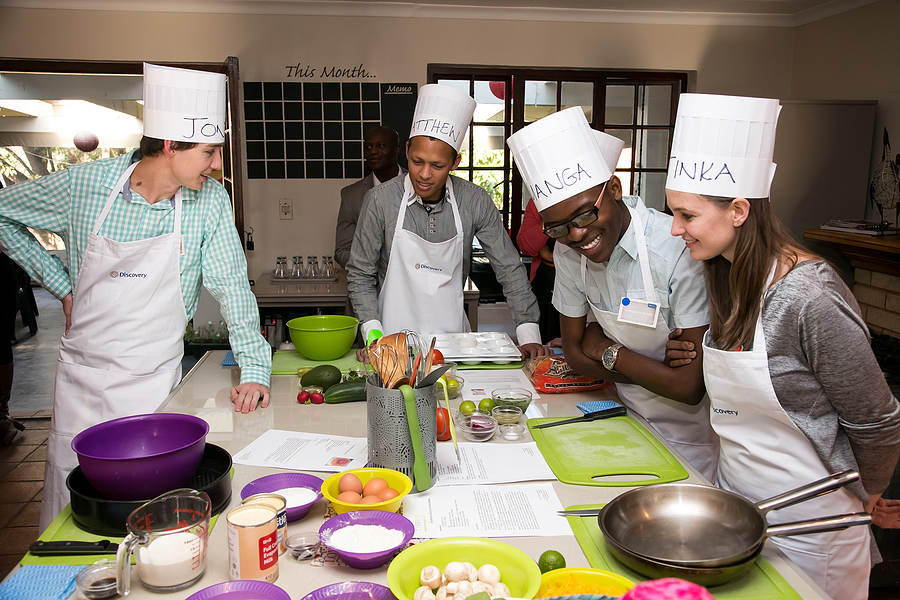
We’ve used a mix of options to make the experience the best it can be. Sometimes we start in a specialized setting and then move to a more inclusive one once the skills are learned. There are also opportunities to participate in wider experiences. For example, my son is doing so well in therapeutic horseback riding that he will soon be able to participate in shows. He also loves to sing and is invited every year to be in the Christmas group number at a voice studio that my husband accompanies at. My daughter made so many paintings in her art class that she was offered a show in a local café to sell her artworks.
Inclusive programs may not always be able to live up to the definition, for various reasons. There are many methods and ideas for helping community organizations and the people they serve come closer to the ideal. Education and acceptance are two big pieces. Community inclusion is important because everyone needs to feel like they belong. Autistic people can bring significant gifts to community settings. All members of society benefit from interacting with a wide range of people who think and act differently. The world is a diverse place and neurodiversity is a big part of it.
|
|
|
Autism Society Alberta is Hiring

The ASA Family Resource Centre is expanding our team in Lethbridge! Click on the images below to see the full job posting!
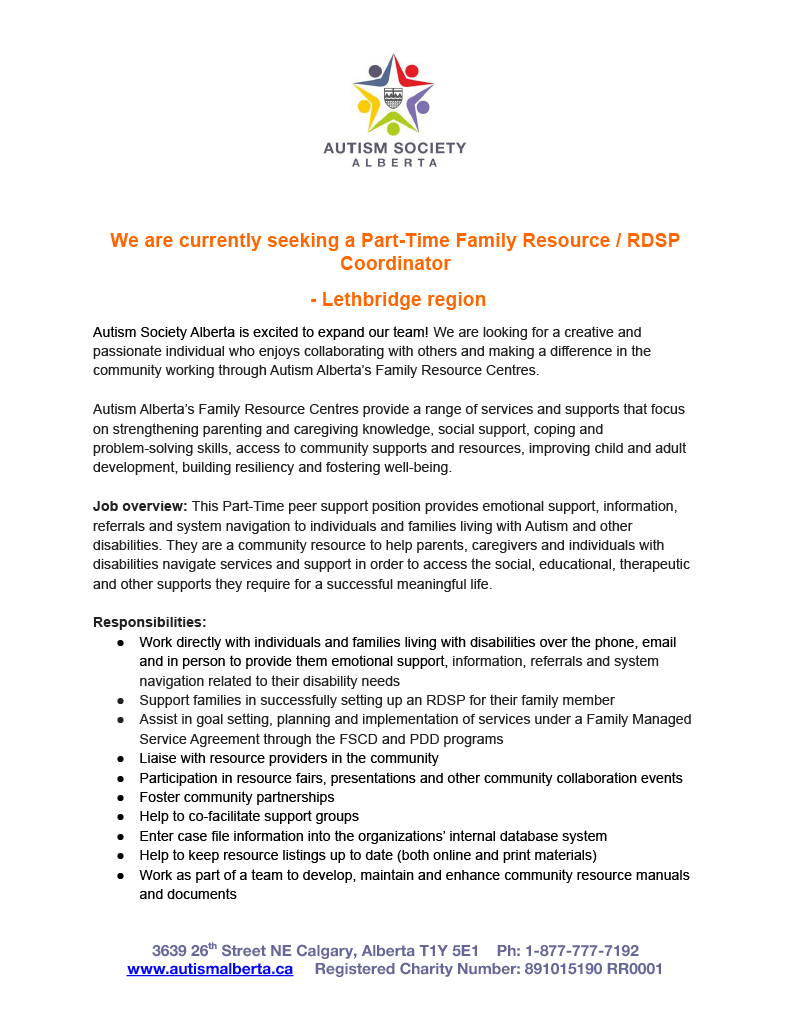 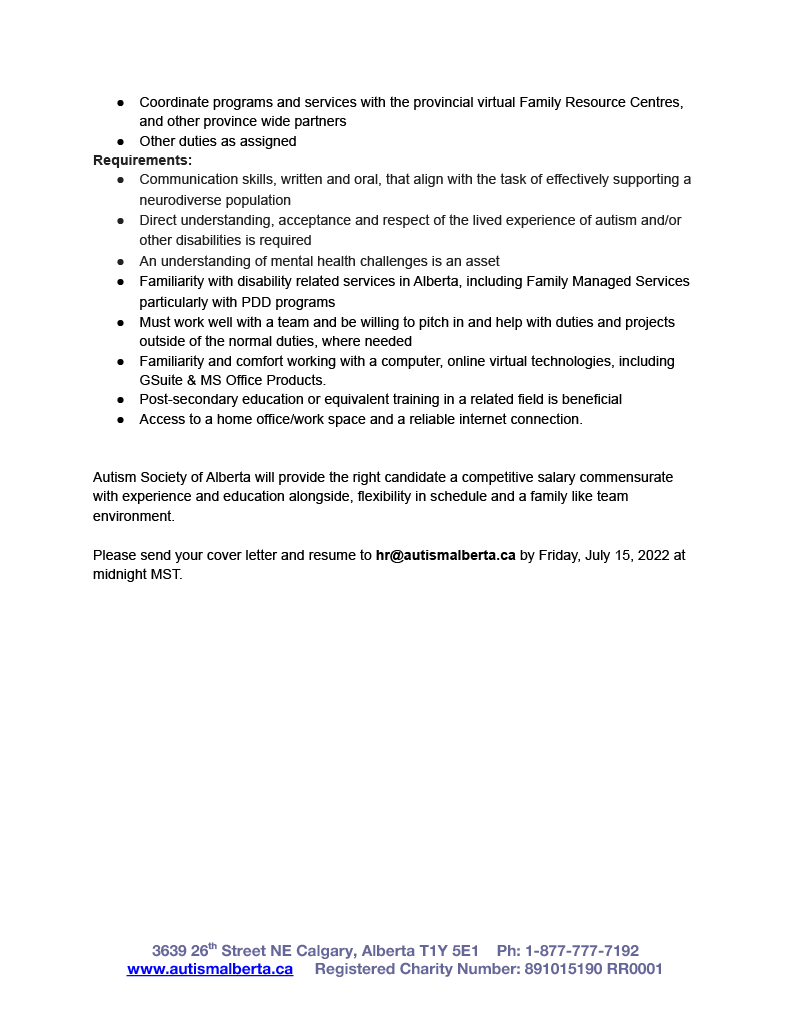
|
|
|
Meet ASA's Family Resource Coordinators

Hello, everyone! My name is Lorraine Reno. I am a Family Resource Coordinator with Autism Society Alberta’s Family Resource Centres. My areas of support are the Crowsnest Pass and Pincher Creek all inclusive.
I have one daughter. She is autistic and has ADHD. I work with adults with disabilities, as well. The combination of these two worlds has put me on the most incredible journey I have ever been on. I have met so many amazing people along the way and have learned so much from them. I will always be grateful for this. If I can assist you with finding resources to help your family, please contact me. I would be more than happy to talk with you and see what we can do together.
Lorraine can be reached at FRCcrowsnest@autismalberta.ca
|
|
|
|
|